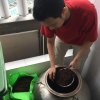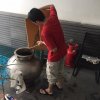Let's talk Oud: a detailed discourse on the various aspects of this substance we love
- Thread starter Taha
- Start date
Here's a video of Taha collecting the initial portion of Vietnam Special K's base note fractions.

Very fresh oil. Not even fully cured and tightened, yet the aroma is outstanding. Lasts atleast a few hours (right after the visit, I did some groceries while sniffing my arm in the supermarket looking like some addict).
Super rich to the dry down. Taha graciously heated shavings of his precious Brunei Kinam that day, and the initial whiffs were almost identical to the top notes of the oil. I wonder what "Special K" might be referring to
More videos coming soon ! Perhaps some coffee bean roasting secrets?


Very fresh oil. Not even fully cured and tightened, yet the aroma is outstanding. Lasts atleast a few hours (right after the visit, I did some groceries while sniffing my arm in the supermarket looking like some addict).
Super rich to the dry down. Taha graciously heated shavings of his precious Brunei Kinam that day, and the initial whiffs were almost identical to the top notes of the oil. I wonder what "Special K" might be referring to
More videos coming soon ! Perhaps some coffee bean roasting secrets?
Last edited:
Here's a video of Taha collecting the initial portion of Vietnam Special K's base note fractions.
View attachment 476
Very fresh oil. Not even fully cured and tightened, yet the aroma is outstanding. Lasts atleast a few hours (right after the visit, I did some groceries while sniffing my arm in the supermarket looking like some addict).
Super rich to the dry down. Taha graciously heated shavings of his precious Brunei Kinam that day, and the initial whiffs were almost identical to the top notes of the oil. I wonder what "Special K" might be referring to
More videos coming soon ! Perhaps some coffee bean roasting secrets?

View attachment 476
Very fresh oil. Not even fully cured and tightened, yet the aroma is outstanding. Lasts atleast a few hours (right after the visit, I did some groceries while sniffing my arm in the supermarket looking like some addict).
Super rich to the dry down. Taha graciously heated shavings of his precious Brunei Kinam that day, and the initial whiffs were almost identical to the top notes of the oil. I wonder what "Special K" might be referring to
More videos coming soon ! Perhaps some coffee bean roasting secrets?

Judging by the color, the aroma (and the unexpected sheer volume) of this current pull, I think what we pulled together (in the video above) was probably not the base note fractions.
I had thought either today or tomorrow I'd switch the condenser setup (for the second time), this time a shotgun type. However, the hydrosol is still cloudy and sweet, and the pull size was substantial, so... it looks like I gotta 'fundoshi o shimete kakaru'... tighten my loincloth, i.e. roll up my sleeves, not be a 'pink pony', and carry on with the current set up.
As a side note, here's some food for thought-
Some of you asked me in private how much this will go for, and my obvious answer was: I don't know, it depends on the total yield.
All this while, my fear has been that I would not be able to match my cost to Ensar's prices.
Think about that...
My COST to Ensar's PRICE.
I failed with Sultan's Succor (it was slightly more expensive than his Xiang Liao Ling).
So here I am, with all these shmancy yield boost techniques and so on, and I'm hoping I can MATCH Ensar's prices?!
Want to know the answer?
If I add in the MINIMUM WAGE for a labor worker in ('third world') Malaysia as my profit, this oil is presently still more costly than Ensar's most expensive Vietnamese oil. Maybe yet again I'm just distilling an uber expensive oil that will just sit in my private collection, never to be released for fear of the MOCA police's finger wagging.
When (and why, and how) did oud oils end up being viewed the same as socks and batteries — a mere 'commodity' devoid of the aesthetic aspect that should be price-matched by hunting around at different discount stores to find the 'best deal'...
What on earth is happening to the oud market.....
And why do I have a feeling I'll regret posting this, once I finally (one day!) manage to catch up on lost sleep..
Now please excuse me while I go and grind up 15 kilos of Khao Yai wood for the next 6 or so hours. Note to self: add 1,000 calories and an additional espresso shot to today's menu plan.
@Taha so from what I understand, there's still lots of oil gushing out unexpectedly?
Thai next eh. Back to back distillations.. Agar Aura is on a roll BTW Would you mind if I upload the video of you roasting the beans? The action itself might not be a problem but there may be some commentaries here and there.
BTW Would you mind if I upload the video of you roasting the beans? The action itself might not be a problem but there may be some commentaries here and there.
Thai next eh. Back to back distillations.. Agar Aura is on a roll
Not really a 'lot' in the sense that most distillers do it quite a bit faster (triple to quadruple the pull quantity per day), but yes considering how much I stretch out my distillations, yes, its 'a lot'. Considering. 
The roasting video.... well, sure if you want. Dunno how useful it will be though, considering you just shot a short clip, ha!
The roasting video.... well, sure if you want. Dunno how useful it will be though, considering you just shot a short clip, ha!
Thanks bhanny! Yeah, I'm pretty excited too. Let's see how beefy the legs on this bad boy are. Today I finally pulled out the big gun (pun intended... 'shotgun' condenser) for the latter heart and base note fractions. Some more oil was collected before that, and now with the new setup I can see some more oil (see second photo - that's not dirt by the way, that's flecks of oil swimming around in the water).
Looks like the oil may be sub-$2,000 per bottle after all.


Looks like the oil may be sub-$2,000 per bottle after all.


It usually comes down to 5 things:
1) the actual color of the oleoresin inside the wood. Have you ever smelled blue oud oils? If you have, you'll notice that they ALL share a certain note in common which is absent in non-blue oud oils. That note is in fact similar to a facet of blue essential oils like Blue Tansy and Australian Blue Cypress.
And so, the first factor is the natural color of the oleoresin in the wood itself. Some are naturally yellowish, others greenish, and others reddish. Some are naturally lighter, others naturally darker.
2) the grind setting. Typically, a finer powder will yield a darker oil due to more direct exposure of the oleoresin to heat, whereas with a rougher grind the oleoresin will be 'buffered' by the wood fibres, and thus the oil will typically be lighter.
3) directly related to the point above: the cooking temperature. In most cases, a higher temperature will give a lighter oil. Same reason as above^
4) pot size. Usually a smaller pot will be more efficient at conducting heat, allowing a lower cooking temperature = lighter color. Killer Koh Kong was cooked in a 3kg pot, and Vietnam Special K is being cooked in a 15kg pot. So... obviously this isn't always true (refer back to point #1).
5) copper vs steel. The former will typically give a lighter oil and the latter a darker oil. Not always the case (once again, Koh Kong was copper vs Ha Tinh is steel).
..........and a bunch of variables can be tinkered with, to counter each of the above.
So, in summary, yes typically color is dictated by the above-mentioned techniques+apparatus variables. However, the way I do it, its not techniques+apparatus that determine the color but rather the oleoresin's natural color itself that does.
m.arif can tell you the Cambodian was cooked at a SUPER low temperature, in a TINY COPPER pot, so one would think the oil would be very light and yet its almost black.
By the way, the color of the Vietnamese oil's base note fractions isn't very accurate/clear in the photo above because its silhouetted against the brighter background. Here's another photo that better captures the color:

1) the actual color of the oleoresin inside the wood. Have you ever smelled blue oud oils? If you have, you'll notice that they ALL share a certain note in common which is absent in non-blue oud oils. That note is in fact similar to a facet of blue essential oils like Blue Tansy and Australian Blue Cypress.
And so, the first factor is the natural color of the oleoresin in the wood itself. Some are naturally yellowish, others greenish, and others reddish. Some are naturally lighter, others naturally darker.
2) the grind setting. Typically, a finer powder will yield a darker oil due to more direct exposure of the oleoresin to heat, whereas with a rougher grind the oleoresin will be 'buffered' by the wood fibres, and thus the oil will typically be lighter.
3) directly related to the point above: the cooking temperature. In most cases, a higher temperature will give a lighter oil. Same reason as above^
4) pot size. Usually a smaller pot will be more efficient at conducting heat, allowing a lower cooking temperature = lighter color. Killer Koh Kong was cooked in a 3kg pot, and Vietnam Special K is being cooked in a 15kg pot. So... obviously this isn't always true (refer back to point #1).
5) copper vs steel. The former will typically give a lighter oil and the latter a darker oil. Not always the case (once again, Koh Kong was copper vs Ha Tinh is steel).
..........and a bunch of variables can be tinkered with, to counter each of the above.
So, in summary, yes typically color is dictated by the above-mentioned techniques+apparatus variables. However, the way I do it, its not techniques+apparatus that determine the color but rather the oleoresin's natural color itself that does.
m.arif can tell you the Cambodian was cooked at a SUPER low temperature, in a TINY COPPER pot, so one would think the oil would be very light and yet its almost black.
By the way, the color of the Vietnamese oil's base note fractions isn't very accurate/clear in the photo above because its silhouetted against the brighter background. Here's another photo that better captures the color:

It usually comes down to 5 things:
1) the actual color of the oleoresin inside the wood. Have you ever smelled blue oud oils? If you have, you'll notice that they ALL share a certain note in common which is absent in non-blue oud oils. That note is in fact similar to a facet of blue essential oils like Blue Tansy and Australian Blue Cypress.
And so, the first factor is the natural color of the oleoresin in the wood itself. Some are naturally yellowish, others greenish, and others reddish. Some are naturally lighter, others naturally darker.
2) the grind setting. Typically, a finer powder will yield a darker oil due to more direct exposure of the oleoresin to heat, whereas with a rougher grind the oleoresin will be 'buffered' by the wood fibres, and thus the oil will typically be lighter.
3) directly related to the point above: the cooking temperature. In most cases, a higher temperature will give a lighter oil. Same reason as above^
4) pot size. Usually a smaller pot will be more efficient at conducting heat, allowing a lower cooking temperature = lighter color. Killer Koh Kong was cooked in a 3kg pot, and Vietnam Special K is being cooked in a 15kg pot. So... obviously this isn't always true (refer back to point #1).
5) copper vs steel. The former will typically give a lighter oil and the latter a darker oil. Not always the case (once again, Koh Kong was copper vs Ha Tinh is steel).
..........and a bunch of variables can be tinkered with, to counter each of the above.
So, in summary, yes typically color is dictated by the above-mentioned techniques+apparatus variables. However, the way I do it, its not techniques+apparatus that determine the color but rather the oleoresin's natural color itself that does.
m.arif can tell you the Cambodian was cooked at a SUPER low temperature, in a TINY COPPER pot, so one would think the oil would be very light and yet its almost black.
By the way, the color of the Vietnamese oil's base note fractions isn't very accurate/clear in the photo above because its silhouetted against the brighter background. Here's another photo that better captures the color:
View attachment 480
1) the actual color of the oleoresin inside the wood. Have you ever smelled blue oud oils? If you have, you'll notice that they ALL share a certain note in common which is absent in non-blue oud oils. That note is in fact similar to a facet of blue essential oils like Blue Tansy and Australian Blue Cypress.
And so, the first factor is the natural color of the oleoresin in the wood itself. Some are naturally yellowish, others greenish, and others reddish. Some are naturally lighter, others naturally darker.
2) the grind setting. Typically, a finer powder will yield a darker oil due to more direct exposure of the oleoresin to heat, whereas with a rougher grind the oleoresin will be 'buffered' by the wood fibres, and thus the oil will typically be lighter.
3) directly related to the point above: the cooking temperature. In most cases, a higher temperature will give a lighter oil. Same reason as above^
4) pot size. Usually a smaller pot will be more efficient at conducting heat, allowing a lower cooking temperature = lighter color. Killer Koh Kong was cooked in a 3kg pot, and Vietnam Special K is being cooked in a 15kg pot. So... obviously this isn't always true (refer back to point #1).
5) copper vs steel. The former will typically give a lighter oil and the latter a darker oil. Not always the case (once again, Koh Kong was copper vs Ha Tinh is steel).
..........and a bunch of variables can be tinkered with, to counter each of the above.
So, in summary, yes typically color is dictated by the above-mentioned techniques+apparatus variables. However, the way I do it, its not techniques+apparatus that determine the color but rather the oleoresin's natural color itself that does.
m.arif can tell you the Cambodian was cooked at a SUPER low temperature, in a TINY COPPER pot, so one would think the oil would be very light and yet its almost black.
By the way, the color of the Vietnamese oil's base note fractions isn't very accurate/clear in the photo above because its silhouetted against the brighter background. Here's another photo that better captures the color:
View attachment 480
@Taha referring to point number 3, you said generally higher temp=lighter oil. In reference to point 2, you said finer grind will result in darker colour due to more exposure to heat. I understood from p.2 that more heat= darker. But point 3 is higher temp = lighter?
As for the koh kong distillation, cool looking copper pot, super cool condenser (fluids at a temperature that I'd quench my thirst with on a hot Malaysian day). I only saw the top note fractions I think. Then Taha showed me the final product last week, I was very surprised. Very dark, almost opaque.
Now since the grind usually affects the end product, if any of you guys want some of the koh kong post distillation wood dust, let me know. I'll be glad to send some for reference and collection. *only for active Gaharu members*. postage cost required though(cheap one)
*only for active Gaharu members*. postage cost required though(cheap one)
You guys can see how the grind level does not correlate with the standard rule for colour as in the points Taha mentioned. probably due to point 1, the natural oleoresin itself is dark...or Taha has some secret recipe to make his oils bypass the rules.
As for the koh kong distillation, cool looking copper pot, super cool condenser (fluids at a temperature that I'd quench my thirst with on a hot Malaysian day). I only saw the top note fractions I think. Then Taha showed me the final product last week, I was very surprised. Very dark, almost opaque.
Now since the grind usually affects the end product, if any of you guys want some of the koh kong post distillation wood dust, let me know. I'll be glad to send some for reference and collection.
You guys can see how the grind level does not correlate with the standard rule for colour as in the points Taha mentioned. probably due to point 1, the natural oleoresin itself is dark...or Taha has some secret recipe to make his oils bypass the rules.
Distillation life cycle... aka a day in the life of Taha, in pictures.
They say a picture is worth a thousand words. Well, I wish the photo could have captured the beads of sweat shooting from my head. Meanwhile, @m.arif didn't even break a sweat.. you Malay you!
Many thanks for your help! The seal is beautiful, the alignment of everything is perfect, and maybe you even got a nice enjoyable workout out of this.
1) 4 shots of Ethiopian Full-City roast coffee (notes of blueberries, cacao nibs, and black pepper). @Taherg I hope you enjoyed the little baggie I sent your way. Don't forget you just have 1 or 2 days left, before the flavor starts going downhill.

2) I ended up hiring the building handyman Ripon to assist me with the grinding, dhonyabad bondhu! Best RM100 I ever spent. Hardest RM100 he ever earned.

3) Wild Thai wood all ground up!

4) Draining the contents of the previous distillation, to make it easier to carry it to the back for washing.

5) Use dem biceps boah! (its heavier than it looks).

6) m.arif gets to keep the awesome Vietnamese post-distillation wood as a reward for his slave labor

7) Thoroughly washing the pot (its harder than it looks).

8) Carrying the pot back, to start the Thai run right away. Can't waste a single day!

9) Pouring the Thai wood into the pot.

10) Censored: photo of the full setup won't be posted online, as it reveals too much. But you're all welcome to swing by any time to check her out in person.
They say a picture is worth a thousand words. Well, I wish the photo could have captured the beads of sweat shooting from my head. Meanwhile, @m.arif didn't even break a sweat.. you Malay you!
Many thanks for your help! The seal is beautiful, the alignment of everything is perfect, and maybe you even got a nice enjoyable workout out of this.
1) 4 shots of Ethiopian Full-City roast coffee (notes of blueberries, cacao nibs, and black pepper). @Taherg I hope you enjoyed the little baggie I sent your way. Don't forget you just have 1 or 2 days left, before the flavor starts going downhill.

2) I ended up hiring the building handyman Ripon to assist me with the grinding, dhonyabad bondhu! Best RM100 I ever spent. Hardest RM100 he ever earned.

3) Wild Thai wood all ground up!

4) Draining the contents of the previous distillation, to make it easier to carry it to the back for washing.

5) Use dem biceps boah! (its heavier than it looks).

6) m.arif gets to keep the awesome Vietnamese post-distillation wood as a reward for his slave labor

7) Thoroughly washing the pot (its harder than it looks).

8) Carrying the pot back, to start the Thai run right away. Can't waste a single day!

9) Pouring the Thai wood into the pot.

10) Censored: photo of the full setup won't be posted online, as it reveals too much. But you're all welcome to swing by any time to check her out in person.
Simple: preserve its original aroma. 
This particular batch of wood was rather intensely aromatic (and ambiently so!). Quite different from most Thais, neither fruity like the Trat type nor zingy like southwest / Pattani type, there's a rather unusual sweet green + bitter black streak that runs through it and I really want to capture that in the oil. I even got a couple leaves from the tree, and it ain't Crassna or any other species I've worked with before. Whatever it is, its the first time I'm working with this type so I hope it turns out nice!
This particular batch of wood was rather intensely aromatic (and ambiently so!). Quite different from most Thais, neither fruity like the Trat type nor zingy like southwest / Pattani type, there's a rather unusual sweet green + bitter black streak that runs through it and I really want to capture that in the oil. I even got a couple leaves from the tree, and it ain't Crassna or any other species I've worked with before. Whatever it is, its the first time I'm working with this type so I hope it turns out nice!
Awesome Taha. I have a strange attraction for these non-super-fruity Thai oils. And you have hit some key words for old bhanny, green, bitter and sweet. And duh Brian, of course Taha is going preserve the original wood/resin aroma! Can't wait to hear of the progress.
This particular distillation was a looooooong time coming. Wild Thai, especially south Thai, is very difficult because of the political situation there. You know what I find intriguing? Oud from regions in turmoil seem to have extra soul...
Distillation life cycle... aka a day in the life of Taha, in pictures.
They say a picture is worth a thousand words. Well, I wish the photo could have captured the beads of sweat shooting from my head. Meanwhile, @m.arif didn't even break a sweat.. you Malay you!
Many thanks for your help! The seal is beautiful, the alignment of everything is perfect, and maybe you even got a nice enjoyable workout out of this.
1) 4 shots of Ethiopian Full-City roast coffee (notes of blueberries, cacao nibs, and black pepper). @Taherg I hope you enjoyed the little baggie I sent your way. Don't forget you just have 1 or 2 days left, before the flavor starts going downhill.
View attachment 486
2) I ended up hiring the building handyman Ripon to assist me with the grinding, dhonyabad bondhu! Best RM100 I ever spent. Hardest RM100 he ever earned.
View attachment 487
3) Wild Thai wood all ground up!
View attachment 488
4) Draining the contents of the previous distillation, to make it easier to carry it to the back for washing.
View attachment 489
5) Use dem biceps boah! (its heavier than it looks).
View attachment 490
6) m.arif gets to keep the awesome Vietnamese post-distillation wood as a reward for his slave labor
View attachment 491
7) Thoroughly washing the pot (its harder than it looks).
View attachment 492
8) Carrying the pot back, to start the Thai run right away. Can't waste a single day!
View attachment 493
9) Pouring the Thai wood into the pot.
View attachment 494
10) Censored: photo of the full setup won't be posted online, as it reveals too much. But you're all welcome to swing by any time to check her out in person.
They say a picture is worth a thousand words. Well, I wish the photo could have captured the beads of sweat shooting from my head. Meanwhile, @m.arif didn't even break a sweat.. you Malay you!
Many thanks for your help! The seal is beautiful, the alignment of everything is perfect, and maybe you even got a nice enjoyable workout out of this.
1) 4 shots of Ethiopian Full-City roast coffee (notes of blueberries, cacao nibs, and black pepper). @Taherg I hope you enjoyed the little baggie I sent your way. Don't forget you just have 1 or 2 days left, before the flavor starts going downhill.
View attachment 486
2) I ended up hiring the building handyman Ripon to assist me with the grinding, dhonyabad bondhu! Best RM100 I ever spent. Hardest RM100 he ever earned.
View attachment 487
3) Wild Thai wood all ground up!
View attachment 488
4) Draining the contents of the previous distillation, to make it easier to carry it to the back for washing.
View attachment 489
5) Use dem biceps boah! (its heavier than it looks).
View attachment 490
6) m.arif gets to keep the awesome Vietnamese post-distillation wood as a reward for his slave labor
View attachment 491
7) Thoroughly washing the pot (its harder than it looks).
View attachment 492
8) Carrying the pot back, to start the Thai run right away. Can't waste a single day!
View attachment 493
9) Pouring the Thai wood into the pot.
View attachment 494
10) Censored: photo of the full setup won't be posted online, as it reveals too much. But you're all welcome to swing by any time to check her out in person.
Satisfied. Grateful for the knowledge and experience shared. I think I might have some talent in making bread after making 'rye snakes' yesterday.
Really guys, the pot is SUPER HEAVY . I cannot imagine a guy with flabby arms and a big belly doing distillation all by himself. Heck, even an average guy with no muscles will have a nightmare doing all the distillation work (thankfully I had the gym junkie, Mr Taha doing most of the heavy powerlifting).
The temperature was around ideal for me though. So that was good
My first time seeing and smelling genuine wild thai wood. Very enlightening, since I'm used to the fruity sweet stuff from plantations. Bitter and dry, very strange (atleast for me).
I'll be learning a lot from this coming thai oil.
You're welcome @Taha , and many thanks for everything! Awesome coffee, awesome vietnamese bead shavings! they are very aromatic. Well here I am drying 7kg of vietnamese wood in my 3 room apartment. Add to that the rain and cloudy weather, my store room is where the wood will be.
Anywho, again, if any of you guys want some of the wood let me know.
It was a great experience. so guys start buffing up if you ever want to try out agarwood distillation.
awesome vietnamese bead shavings! they are very aromatic. Well here I am drying 7kg of vietnamese wood in my 3 room apartment. Add to that the rain and cloudy weather, my store room is where the wood will be.
Anywho, again, if any of you guys want some of the wood let me know.
Anywho, again, if any of you guys want some of the wood let me know.
